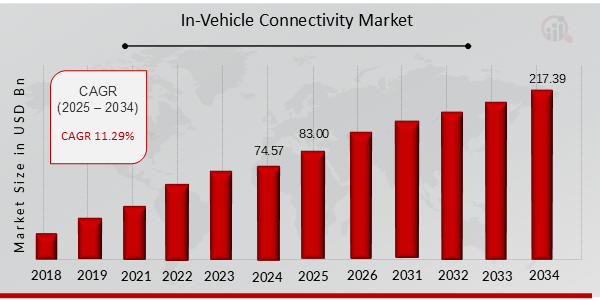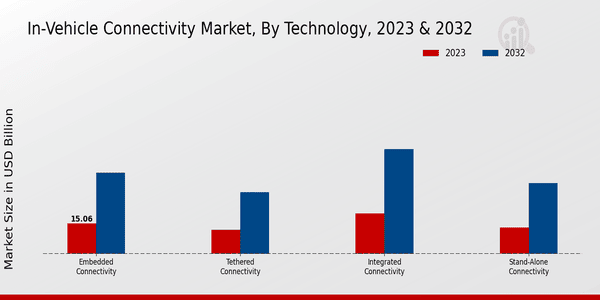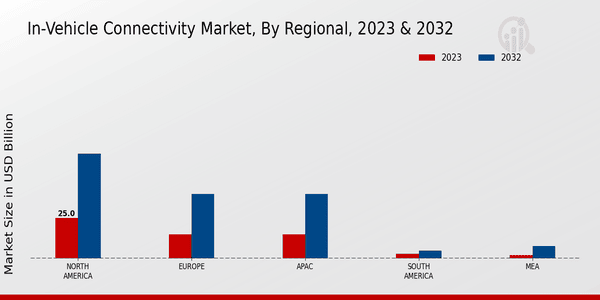In-Vehicle Connectivity Market Overview:
As per MRFR analysis, the In-Vehicle Connectivity Market Size was estimated at 74.57 (USD Billion) in 2024. The In-Vehicle Connectivity Market Industry is expected to grow from 83.00 (USD Billion) in 2025 to 217.39 (USD Billion) till 2034, at a CAGR (growth rate) is expected to be around 11.29% during the forecast period (2025 - 2034).
Key In-Vehicle Connectivity Market Trends Highlighted
The In-Vehicle Connectivity Market is propelled by several key drivers. The growing demand for enhanced in-car experiences is a significant factor as consumers increasingly seek seamless integration with their digital lifestyles. Advancements in wireless technologies, such as 5G and the Internet of Things, further accelerate this trend, allowing for faster and more reliable connections within vehicles. Additionally, the push for smarter and more automated vehicles is contributing to the integration of connectivity solutions, enabling features such as real-time traffic updates, remote diagnostics, and over-the-air updates. Sustainability is also becoming a driver as manufacturers look to create eco-friendly, connected solutions.
There are numerous opportunities to be explored within this evolving landscape. The rise of electric vehicles presents a unique chance to integrate connectivity solutions that monitor battery performance and charging infrastructure. Moreover, the growing interest in autonomous vehicles necessitates advanced connectivity systems to ensure safety and communication between vehicles and infrastructure. This presents an attractive prospect for technology providers and automobile manufacturers to collaborate and innovate. Recent trends indicate an increasing focus on user-friendly interfaces and personalized experiences within vehicles. With advancements in artificial intelligence and machine learning, systems are becoming more intuitive, adapting to driver behavior and preferences.
The integration of smart technologies, like voice recognition and gesture control, is further transforming how users interact with their vehicles. As more consumers embrace digital lifestyles, the demand for connecting vehicles to personal devices is also on the rise, shaping the future of transportation into a more interconnected ecosystem. Such trends underscore the ongoing evolution of in-vehicle connectivity, making it a vital area for growth and innovation within the automotive industry.

Source: Primary Research, Secondary Research, MRFR Database and Analyst Review
In-Vehicle Connectivity Market Drivers
Rising Consumer Demand for Advanced Connectivity Features
The In-Vehicle Connectivity Market Industry is experiencing significant growth due to an increasing consumer demand for advanced connectivity features in automobiles. As technology continues to evolve, consumers are seeking in-vehicle systems that offer seamless integration with their personal devices, such as smartphones and tablets. This has resulted in a shift towards vehicles equipped with enhanced connectivity options, including Wi-Fi hotspots, Bluetooth connectivity and mobile app interfaces.
Furthermore, features like real-time navigation, remote diagnostics, and over-the-air updates are becoming essential for enhancing user experience and convenience. As consumers become more accustomed to connected lifestyles, their expectations for vehicle connectivity become more demanding.
The desire for in-car entertainment and information services is also a major driving force behind this trend. In addition, the rise of smart technologies, such as IoT solutions and artificial intelligence, further pressures automakers to innovate and improve connectivity standards within their vehicles.All these factors collectively contribute to the expansion of the Global In-Vehicle Connectivity Market, positioning it for robust growth in the years to come.
Government Initiatives and Regulations
Government initiatives and regulations aimed at increasing vehicle safety and reducing traffic accidents are significantly influencing the In-Vehicle Connectivity Market Industry. Governments around the world are implementing stringent safety standards that necessitate the integration of advanced connectivity technologies in vehicles. For instance, regulations promoting the use of Vehicle-to-Everything (V2X) communication systems are encouraging manufacturers to adopt connected vehicle technologies that facilitate communication between vehicles, infrastructure, and pedestrians.
By mandating features such as automatic emergency braking and lane-keeping assistance, authorities are pushing the industry towards enhanced connectivity solutions, which, in turn, drive market growth. This movement not only aims to ensure safer driving conditions but also fosters innovation and advancements within the sector.
Integration of Smart Technologies
The rapid integration of smart technologies in vehicles is a crucial driver for the In-Vehicle Connectivity Market Industry. With the advent of technologies such as Artificial Intelligence (AI), Machine Learning (ML), and IoT, vehicles are becoming smarter and more connected than ever before. AI enables features such as voice recognition and predictive maintenance, while IoT technologies facilitate vehicle data exchange and real-time analytics.
This integration enhances user experience and increases the functional capabilities of vehicles, leading to higher consumer preference for advanced connectivity options. As automakers recognize the importance of remaining competitive, they are increasingly investing in the development and implementation of these smart technologies, thereby further propelling growth in the in-vehicle connectivity market.
In-Vehicle Connectivity Market Segment Insights:
In-Vehicle Connectivity Market Technology Insights
The In-Vehicle Connectivity Market encompasses a robust technology segment, poised for substantial growth driven by enhanced consumer demand for connected vehicles and advancements in communication infrastructure. In 2023, the overall market is valued at 60.21 USD Billion and is projected to experience a significant transformation by 2032, reaching a value of 157.6 USD Billion, showcasing the escalating interest in connectivity technologies within the automotive industry. The market segmentation reveals critical insights, with Embedded Connectivity valued at 15.06 USD Billion in 2023, expected to expand to 40.13 USD Billion by 2032.
This segment plays a pivotal role as it integrates connectivity features directly into the vehicle's hardware, enhancing functionality and user experience, thereby reflecting its significant contribution to the overall market growth. Tethered Connectivity, on the other hand, demonstrates a valuation of 12.04 USD Billion in 2023, with expectations to rise to 30.52 USD Billion by 2032, indicating a strong consumer preference for smartphone integration and seamless connectivity within the car. Integrated Connectivity represents another major aspect, holding a market value of 20.11 USD Billion in 2023 and projected to grow to 51.9 USD Billion by 2032.This segment distinctly dominates the landscape due to its capability to unify various connectivity features, appealing significantly to tech-savvy consumers desiring comprehensive connectivity solutions. Lastly, Stand-Alone Connectivity, valued at 13.0 USD Billion in 2023, is anticipated to expand to 35.05 USD Billion by 2032, catering to consumers who prefer auxiliary devices that ensure connectivity independently of vehicle systems. Collectively, these valued sub-segments enrich the In-Vehicle Connectivity Market revenue through diversified consumer needs, enhancing overall industry statistics.
Market trends suggest that growing technological innovations, emphasizing vehicle-to-everything (V2X) communication and smart mobility, significantly propel the demand within these segments. However, challenges such as cybersecurity concerns in connected vehicles present obstacles to sustained growth. Nevertheless, the opportunities for service integrations, such as infotainment and navigation systems, alongside the rise of autonomous vehicles, create a dynamic environment for the technology segment, enhancing competitiveness and market presence in the evolving automotive landscape.

Source: Primary Research, Secondary Research, MRFR Database and Analyst Review
In-Vehicle Connectivity Market Applications Insights
The In-Vehicle Connectivity Market showcases a robust and dynamic landscape, particularly within the Applications segment, which encompasses critical areas such as Infotainment, Navigation, Vehicle Management and Communication. Infotainment applications, with their rich multimedia capabilities, play a pivotal role in attracting consumers seeking entertainment during travel, thus significantly contributing to overall market expansion.
Navigation systems have become essential for efficient travel, owing to the demand for real-time traffic updates and route optimization. Vehicle Management applications support automotive manufacturers by providing critical data for maintenance and improved vehicle performance, which is becoming increasingly vital as technology evolves. Communication applications serve as the backbone of vehicular connectivity, allowing vehicles to communicate with each other and infrastructure, leading to enhanced safety and efficiency. As these applications continue to evolve, they represent a majority holding within the In-Vehicle Connectivity Market segmentation, showcasing opportunities for innovations and advancements in the automotive industry.Furthermore, exploring new features and integrations stands to fuel future growth, indicating a promising trajectory for this sector.
In-Vehicle Connectivity Market End Use Insights
The market focuses on diverse end uses, including passenger cars, commercial vehicles and public transport. Passenger cars represent a significant portion of the market, primarily driven by consumer demand for enhanced connectivity and infotainment features. Commercial vehicles also play a crucial role, as fleet management systems increasingly rely on connectivity solutions for tracking and operational efficiency. Public transport is gaining traction as cities look to improve the connectivity experience for commuters, harnessing technology for better route management and communication.
This diverse segmentation contributes to the In-Vehicle Connectivity Market statistics, revealing that advancements in technology and the growing need for smart transportation solutions are pivotal to market growth. Overall, the in-vehicle connectivity market showcases dynamic shifts, with each end use demonstrating its unique importance in addressing the challenges and opportunities presented by a more connected world.
In-Vehicle Connectivity Market Network Type Insights
The market, particularly within the network-type segment, is seeing an impressive expansion fueled by various technological advancements and consumer demands for enhanced in-vehicle experiences. Cellular networks hold a substantial position in this landscape, providing reliable connectivity for real-time applications and infotainment systems, making them a critical component for vehicle manufacturers. Satellite networks also play a vital role, especially in remote areas where cellular coverage may be sparse, thus ensuring continuous connectivity for navigation and communication.
Meanwhile, Wi-Fi networks are increasingly integrated into vehicles to facilitate seamless connections and data sharing, enhancing the passenger experience by enabling device connectivity and entertainment options. The interdependence and evolution of these network types are driving the overall market, showcasing a dynamic response to the growing consumer preference for connectivity and data-centric features in vehicles. As the In-Vehicle Connectivity Market data continues to evolve, it presents both growth opportunities and challenges, particularly in ensuring robust security measures and managing the increasing amount of data generated within vehicles.
In-Vehicle Connectivity Market Regional Insights
The In-Vehicle Connectivity Market is expected to witness substantial growth across various regions, with North America holding a majority share valued at 25.0 USD Billion in 2023, projected to grow to 65.0 USD Billion by 2032. This region's dominance can be attributed to the rapid adoption of advanced technologies and a robust automotive industry. Europe follows, valued at 15.0 USD Billion in 2023 and expected to reach 40.0 USD Billion by 2032, driven by stringent regulations and a strong focus on connectivity solutions. The APAC region, also valued at 15.0 USD Billion in 2023, is expected to grow to 40.0 USD Billion, reflecting a significant increase in vehicle production and consumer preferences in emerging markets.
South America and MEA are comparatively smaller, valued at 3.0 USD Billion and 2.21 USD Billion in 2023, growing to 5.0 USD Billion and 7.6 USD Billion, respectively, by 2032, indicating potential growth opportunities but currently remain less dominant in the Global In-Vehicle Connectivity Market. These regional dynamics highlight the varying pace of market growth driven by innovation, regulatory environments, and consumer technology adoption across the globe.

Source: Primary Research, Secondary Research, MRFR Database and Analyst Review
In-Vehicle Connectivity Market Key Players and Competitive Insights:
The In-Vehicle Connectivity Market is gaining momentum as advancements in technology and consumer demand for enhanced connected experiences continue to shape the automotive landscape. This market encompasses various connectivity solutions, including but not limited to infotainment systems, telematics and vehicle-to-everything (V2X) communication.
The competitive landscape is characterized by both traditional automotive manufacturers and technology companies collaborating to innovate and provide superior connectivity features. With the increasing adoption of smart devices and an emphasis on integrating the digital experience within vehicles, companies are vying for a significant share of this expanding market. Factors such as rapid urbanization, increasing disposable incomes, and a growing focus on sustainability are driving connectivity growth, pushing players to develop more advanced, user-friendly systems.
Toyota holds a significant position in the Global In-Vehicle Connectivity Market, leveraging its rich automotive heritage combined with its focus on innovation to enhance driver and passenger experiences. Known for its reliable and fuel-efficient vehicles, Toyota has strategically invested in connectivity technologies, recognizing the importance of seamless data transfer and connectivity features that elevate user experiences. One of the notable strengths of Toyota is its commitment to research and development, which facilitates the integration of advanced telematics and infotainment systems within its vehicle portfolio. This focus on connectivity not only aligns with modern consumer preferences but also promotes safety and convenience through features that enable drivers to remain connected while on the road. Toyota's global presence further solidifies its competitive edge as it tailors its connectivity solutions to meet diverse market needs across different regions.
General Motors is another key player in the Global In-Vehicle Connectivity Market, marked by its dedication to pioneering technologies that enhance the driving experience. The company's focus on developing robust in-vehicle connectivity solutions is driven by a desire to provide customers with intuitive and versatile functionalities, such as real-time navigation, entertainment options, and vehicle diagnostics. General Motors has invested heavily in its connected services platform, known for its user-friendly interface and seamless integration with smartphones and other external devices. This commitment to connectivity also extends to safety features, where advanced systems aim to connect vehicles to each other and their surroundings, enhancing overall road safety. General Motors continues to evolve and expand its in-vehicle connectivity offerings, catering to the changing demands of consumers while maintaining a strong position in the competitive automotive sector.
Key Companies in the In-Vehicle Connectivity Market Include:
- Toyota
- General Motors
- Volkswagen
- Cisco Systems
- Intel
- Hyundai
- Fiat Chrysler Automobiles
- Daimler
- Qualcomm
- Nissan
- Tesla
- Ford Motor
- Audi
- Honda
- BMW
In-Vehicle Connectivity Market Industry Developments
Recent developments in the In-Vehicle Connectivity Market have showcased a dynamic landscape, with major players like Toyota and General Motors focusing on enhancing their digital platforms to improve user experience and connectivity. Volkswagen is making strides in integrating AI technology into its vehicles, aiming to create smarter and safer driving environments. Cisco Systems and Intel are collaborating with automotive manufacturers to provide robust cybersecurity solutions, ensuring vehicles are protected against potential cyber threats. Additionally, Hyundai and Kia are evolving their strategies by investing in over-the-air updates and cloud-based services for a seamless user experience.
In terms of mergers and acquisitions, notable activity includes Ford Motor's strategic partnership with Qualcomm to leverage 5G technology in its future vehicles, while Tesla continues to expand its software capabilities through various acquisitions to strengthen its dominance in the electric vehicle sector. Market valuations have notably increased, driven by technological advancements and strong consumer demand for connected vehicle features, ultimately impacting businesses across the sector positively. The ongoing enhancements from companies like Audi, Honda, and BMW signify a shift towards connected ecosystems in vehicles, further illustrating the importance of in-vehicle connectivity in the evolving automotive landscape.
In-Vehicle Connectivity Market Segmentation Insights
-
In-Vehicle Connectivity Market Technology Outlook
- Embedded Connectivity
- Tethered Connectivity
- Integrated Connectivity
- Stand-Alone Connectivity
-
In-Vehicle Connectivity Market Applications Outlook
- Infotainment
- Navigation
- Vehicle Management
- Communication
-
In-Vehicle Connectivity Market End Use Outlook
- Passenger Cars
- Commercial Vehicles
- Public Transport
-
In-Vehicle Connectivity Market Network Type Outlook
- Cellular Networks
- Satellite Networks
- Wi-Fi Networks
-
In-Vehicle Connectivity Market Regional Outlook
- North America
- Europe
- South America
- Asia Pacific
- Middle East and Africa
| Report Attribute/Metric |
Details |
|
Market Size 2024
|
74.57 (USD Billion)
|
|
Market Size 2025
|
83.00 (USD Billion)
|
|
Market Size 2034
|
217.39 (USD Billion)
|
|
Compound Annual Growth Rate (CAGR)
|
11.29% (2025 - 2034)
|
|
Report Coverage
|
Revenue Forecast, Competitive Landscape, Growth Factors, and Trends
|
|
Base Year
|
2024
|
|
Market Forecast Period
|
2025 - 2034
|
|
Historical Data
|
2019 - 2023
|
| Market Forecast Units |
USD Billion |
| Key Companies Profiled |
Toyota, General Motors, Volkswagen, Cisco Systems, Intel, Hyundai, Fiat Chrysler Automobiles, Daimler, Qualcomm, Nissan, Tesla, Ford Motor, Audi, Honda, BMW |
| Segments Covered |
Technology, Applications, End Use, Network Type, Regional |
| Key Market Opportunities |
1. Increased demand for autonomous vehicles, 2. Growth of 5G connectivity adoption, 3. Rise in vehicle-to-everything (V2X) communication, 4. Expansion of smart city initiatives, 5. Integration of IoT in transportation |
| Key Market Dynamics |
1. Growing demand for connected cars, 2. Advancements in IoT technology, Rising consumer expectations, 3. Increasing adoption of autonomous vehicles, 4. Government regulations on connectivity standards |
| Countries Covered |
North America, Europe, APAC, South America, MEA |
Frequently Asked Questions (FAQ) :
The In-Vehicle Connectivity Market was expected to be valued at 217.39 USD Billion in 2034.
The expected CAGR for the In-Vehicle Connectivity Market from 2025 to 2034 is 11.29%.
North America is projected to have the largest market share with a valuation of 65.0 USD Billion in 2032.
Embedded Connectivity is valued at 15.06 USD Billion in 2023.
The projected market size for Integrated Connectivity is 51.9 USD Billion by 2032.
Major players in the market include Toyota, General Motors, Volkswagen, and Tesla among others.
The Tethered Connectivity segment is expected to be valued at 30.52 USD Billion in 2032.
The market value for Stand-Alone Connectivity in 2023 is 13.0 USD Billion.
Europe's expected market size is projected to reach 40.0 USD Billion in 2032.
The market is currently challenged by security concerns and the need for continuous technological advancements.

















